by Megan | Jun 24, 2023 | AAC, aided language input, aided language stimulation, blog, modeling
There are so many AAC apps out there – trying to learn all of them so that you can help provide access to those most beneficial for those you work with can be overwhelming, to say the least!
However, let me reassure you that:
- You don’t have to learn ALL the AAC apps/devices simultaneously!
- You don’t have to know ALL the AAC apps/devices before you can start providing AAC therapy.
- You can take your time and learn the apps/devices – building up your knowledge and AAC app repertoire one step at a time!
To illustrate this point, let me share a little bit about my journey as an AAC-loving SLP. Hopefully, this will reassure you that you are doing wonderfully, right where you are.
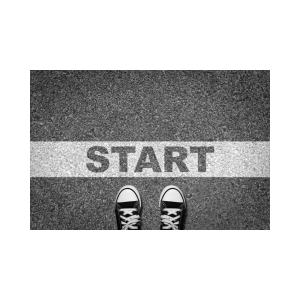
When I started as an SLP, 20 years ago, my first job was in a small elementary school that had one classroom for each grade K-6, two Exceptional Student Education (ESE) Pre-K classes, and four additional self-contained ESE classrooms and I was the only SLP. My caseload was huge and I was constantly on the run. There were lots of things that were difficult about being the only SLP (I’m sure some of you can relate) but I also learned so many invaluable things that have helped me become the SLP I am today.
You may be thinking, “That’s great, but how does this all relate to AAC?” – I’m getting there I promise – just stick with me. 😉

The majority of the students in the four self-contained ESE classrooms, and some of the students in the ESE Pre-K classrooms were non or minimally speaking and needed access to AAC. Thankfully, I knew in grad school I wanted to work with AAC users, however, as a clinical fellow, I still had a lot to learn. But, I did it scared and jumped in with two feet!
As I was learning, on (and off) the job, Dynavox (before they were Tobii Dynavox) was the company that produced the first high-tech devices that I introduced and used with the students I was working with. There were other devices and companies out there and I knew a little bit about them but not everything or much – and that was ok. I started out learning about ONE system. I started on an even smaller scale, learning one feature, option, use, etc, and then moving on to the next.
See how I’m bringing this all back around?

No matter where you are on your AAC SLP journey, there will always be learning opportunities. Take your time, focus in on what you want to and/or need to learn, and start there.
- Have a learner that is using LAMP? Start there…
- Like the layout of Touchchat? Start there…
- Have a learner that needs bilingual support offered by Coughdrop? Start there…
- You get the idea…😀
Don’t forget that you can learn alongside your AAC users as well! That is definitely what I did during that first year as an AAC SLP – and beyond. I think that it is great to learn alongside your learners. It shows the learners that it is ok that they don’t know how to use the device perfectly immediately. You are demonstrating a growth mindset, problem-solving and so much more!

We don’t have the luxury, or the time, to wait to start providing AAC therapy until we know all the different systems, devices, etc – our learners need us now, just as we are, learning alongside them. So, what AAC system/device are you going to learn next?

by Megan | Jun 11, 2023 | AAC, blog, training
Let me tell you about one of my favorite AAC tools. It’s wonderful to have in your back pocket for assessments, goal writing, progress monitoring, and more – and best of all, it’s FREE!
I could go on and on about my love for this tool, but for now, let me introduce you to the Dynamic AAC Goals Grid – 2 (DAGG-2). Here’s a quick overview of what the DAGG-2 gives us: 
- Provides a way to systematically assess/reassess current AAC skills
- Assists with the development of a comprehensive plan for increasing communicative independence for the AAC user.
- Ensures that all communicative competencies are considered in an evaluation.
- Shows patterns of strengths and weaknesses to help determine the next steps for intervention.
- Acknowledges progress toward independence.
- Presents a “big picture” view of every learner and helps develop communication goals for now and the future.
That’s a lot of goodness right there! Let’s break it down step by step and section by section. (It will be helpful if you are able to download the from the link above or at least have it open in another tab while reading through this information to get the clearest picture of each section and its use.)
Let’s start with how to use the DAGG-2 for initial AAC assessments. We start with the “Ability Level Continuum” guide. This guide is broken into five different levels: emergent, emergent transitional, context-dependent, transitional dependent, and independent. Each of these levels are further segmented into specific areas: understanding, expression, social interaction, literacy skills, and other.
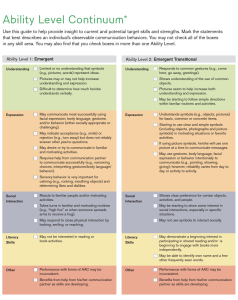
This guide is completed based on the learner’s current AAC use, keeping in mind that a learner may be at different levels for each of the different areas. Information gathered from completing this guide gives insight into the learner’s current skills and strengths in each area. After completing the guide, you can summarize the findings and see an overview of how independent they are within each area. There is also a section where you can make notes of various communication characteristics you observed, other communication modalities they use, strengths, barriers, etc. Once this guide is completed, you move on to the next step – choosing goals to address in one or more areas.
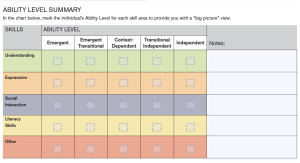
Referencing the information gathered & summarized in the “Ability Level Continuum” guide, we use that information to choose potential goals for the learner, within each of the different communicative competencies. Sample goal ideas are provided both for each communicative competency (linguistic, operational, social, & strategic) and for different levels outlined in the “Ability Level Continuum” guide. A chain of cues prompting hierarchy is also provided for each goal and level so that you can indicate which level of cueing the learner currently needs.
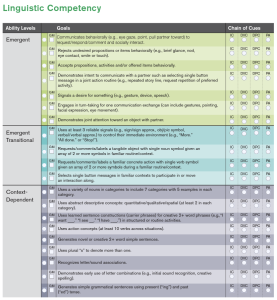
Using the ability levels and chain of cues provides an opportunity to not only see where your learner is currently with their AAC use and their independence, but it also allows you to see the next steps to continue progression and independence within each competency.
Now that we know where our learner is in their AAC use journey in reference to each of the communicative competencies, how independent they are within each of these skills, and have looked at some possible goal ideas, it’s finally time to draft the goals and objectives!
Once again the DAGG-2 is here to help with worksheets that walk us through the goal writing process step by step. AAC Goal Worksheets are here to help us choose a skill from each of the communicative competencies that we selected within the AAC Goals Grid, adding in the communication partner(s), activity, prompting type, and criteria to complete the goal.
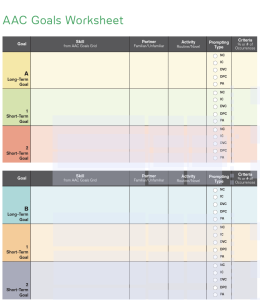
Talk about an all-in-one tool! Just using this one tool you have completed the AAC assessment, determined strengths and areas that need additional support, and written goals and objectives that will drive your treatment sessions! But, the goodness of the DAGG-2 doesn’t stop there! You can also use this tool for reassessments and progress monitoring – read on to find out how.
There are three different ways to look at reassessment & progress monitoring using the DAGG-2:
- Look back at the Dynamic AAC Goals listed by competency and mark any progress in the level of cueing. (Use a different color pen and/or mark the date of reassessment to denote progress monitoring.)
- Use the AAC Goals Periodic Progress Report to record progress in each competency area. Keeping track of the percentage of goals mastered within each competency area will help you track and see when a learner is ready to move towards a different independence level within each competency level.
- Using this information, review the goals you wrote using the AAC Goals Worksheet and revise as needed.
By now I am sure that you are in love with the DAGG-2, just as much as I am but I have a surprise for you – there’s still more goodness to share!
Not only is the DAGG-2 available in paper form, but it is also available digitally, still FREE, through the Pathways for Core First app. Within the digital version of the DAGG-2, you can create “users” for multiple learners, as well as print, save, email, and update individual information as needed. This digital version is a great way to reduce paperwork AND each goal within the goals grid has lesson plans and activity ideas that you can download to help you work with your learners towards achieving their goals! You can access the digital version of the DAGG-2 in the Pathways for Core First app here.
All the steps involved in AAC assessments, selecting goals, progress monitoring, etc can be very daunting and time-consuming. Hopefully, this information and the DAGG-2, either paper or digital versions, will help you feel more confident in your ability to complete these tasks effectively and efficiently!
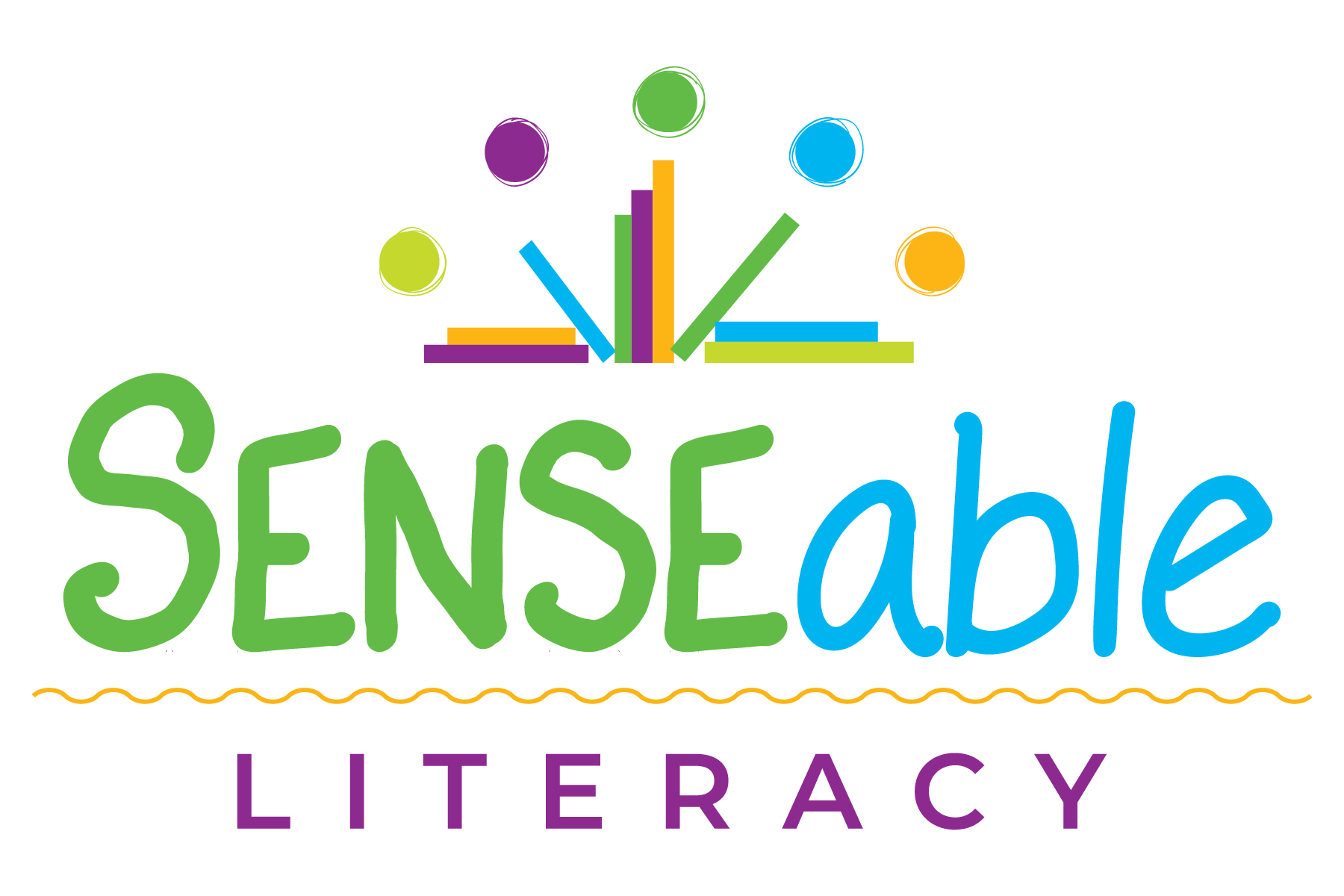










Recent Comments